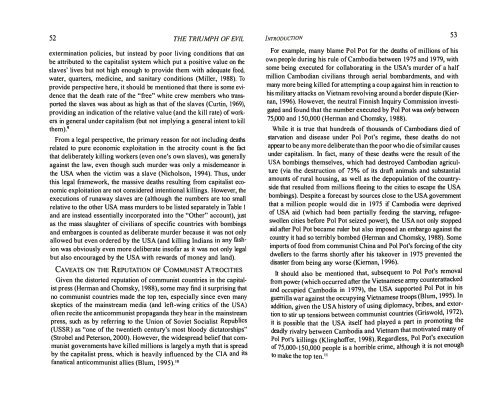austin-murphy-the-triumph-of-evil
austin-murphy-the-triumph-of-evil
austin-murphy-the-triumph-of-evil
You also want an ePaper? Increase the reach of your titles
YUMPU automatically turns print PDFs into web optimized ePapers that Google loves.
52 THE TRIUMPH OF EVIL<br />
extermination policies, but instead by poor living conditions that can<br />
be attributed to <strong>the</strong> capitalist system which put a positive value on <strong>the</strong><br />
slaves' lives but not high enough to provide <strong>the</strong>m with adequate food,<br />
water, quarters, medicine, and sanitary conditions (Miller, 1988). To<br />
provide perspective here, it should be mentioned that <strong>the</strong>re is some evidence<br />
that <strong>the</strong> death rate <strong>of</strong> <strong>the</strong> "free" white crew members who transported<br />
<strong>the</strong> slaves was about as high as that <strong>of</strong> <strong>the</strong> slaves (Curtin, 1969),<br />
providing an indication <strong>of</strong> <strong>the</strong> relative value (and <strong>the</strong> kill rate) <strong>of</strong> workers<br />
in general under capitalism (but not implying a general intent to kill<br />
<strong>the</strong>m).9<br />
From a legal perspective, <strong>the</strong> primary reason for not including deaths<br />
related to pure economic exploitation in <strong>the</strong> atrocity count is <strong>the</strong> fact<br />
that deliberately killing workers (even one's own slaves), was generally<br />
against <strong>the</strong> law, even though such murder was only a misdemeanor in<br />
<strong>the</strong> USA when <strong>the</strong> victim was a slave (Nicholson, 1994). Thus, under<br />
this legal framework, <strong>the</strong> massive deaths resulting from capitalist economic<br />
exploitation are not considered intentional killings. However, <strong>the</strong><br />
executions <strong>of</strong> runaway slaves are (although <strong>the</strong> numbers are too small<br />
relative to <strong>the</strong> o<strong>the</strong>r USA mass murders to be listed separately in Table I<br />
and are instead essentially incorporated into <strong>the</strong> "O<strong>the</strong>r" account), just<br />
as <strong>the</strong> mass slaughter <strong>of</strong> civilians <strong>of</strong> specific countries with bombings<br />
and embargoes is counted as deliberate murder because it was not only<br />
allowed but even ordered by <strong>the</strong> USA (and killing Indians in any fa shion<br />
was obviously even more deliberate ins<strong>of</strong>ar as it was not only legal<br />
but also encouraged by <strong>the</strong> USA with rewards <strong>of</strong> money and land).<br />
CAVEATS ON THE REPUTATION OF COMMUNIST ATROCITIES<br />
Given <strong>the</strong> distorted reputation <strong>of</strong> communist countries in <strong>the</strong> capitalist<br />
press (Herman and Chomsky, 1988), some may find it surprising that<br />
no communist countries made <strong>the</strong> top ten, especially since even many<br />
skeptics <strong>of</strong> <strong>the</strong> mainstream media (and left-wing critics <strong>of</strong> <strong>the</strong> USA)<br />
<strong>of</strong>ten recite <strong>the</strong> anticommunist propaganda <strong>the</strong>y hear in <strong>the</strong> mainstream<br />
press, such as by referring to <strong>the</strong> Union <strong>of</strong> Soviet Socialist Republics<br />
(USSR) as "one <strong>of</strong> <strong>the</strong> twentieth century's most bloody dictatorships"<br />
(Str � bel and Peterson, 2000). However, <strong>the</strong> widespread belief that com-<br />
. mumst governments have killed millions is largely a myth that is spread<br />
by th � capi�list press, which is heavily influenced by <strong>the</strong> CIA and its<br />
fanatical anticommunist allies (Blum, 1995).'0<br />
INTRODUCTION 53<br />
For example, many blame Pol Pot for <strong>the</strong> deaths <strong>of</strong> millions <strong>of</strong> his<br />
own people during his rule <strong>of</strong> Cambodia between 1975 and 1979, with<br />
some being executed for collaborating in <strong>the</strong> USA's murder <strong>of</strong> a half<br />
million Cambodian civilians through aerial bombardments, and with<br />
many more being killed for attempting a coup against him in reaction to<br />
his military attacks on Vietnam revolving around a border dispute (Kiernan,<br />
1996). However, <strong>the</strong> neutral Finnish Inquiry Commission investigated<br />
and fo und that <strong>the</strong> number executed by Pol Pot was only between<br />
75,000 and 150,000 (Herman and Chomsky, 1988).<br />
While it is true that hundreds <strong>of</strong> thousands <strong>of</strong> Cambodians died <strong>of</strong><br />
starvation and disease under Pol Pot's regime, <strong>the</strong>se deaths do not<br />
appear to be any more deliberate than <strong>the</strong> poor who die <strong>of</strong> similar causes<br />
under capitalism. In fact, many <strong>of</strong> <strong>the</strong>se deaths were <strong>the</strong> result <strong>of</strong> <strong>the</strong><br />
USA bombings <strong>the</strong>mselves, which had destroyed Cambodian agriculture<br />
(via <strong>the</strong> destruction <strong>of</strong> 75% <strong>of</strong> its draft animals and substantial<br />
amounts <strong>of</strong> rural housing, as well as <strong>the</strong> depopulation <strong>of</strong> <strong>the</strong> countryside<br />
that resulted from millions fleeing to <strong>the</strong> cities to escape <strong>the</strong> USA<br />
bombings). Despite a forecast by sources close to <strong>the</strong> USA government<br />
that a million people would die in 1975 if Cambodia were deprived<br />
<strong>of</strong> USA aid (which had been partially feeding <strong>the</strong> starving, refugeeswollen<br />
cities before Pol Pot seized power), <strong>the</strong> USA not only stopped<br />
aid after Pol Pot became ruler but also imposed an embargo against <strong>the</strong><br />
country it had so terribly bombed (Herman and Chomsky, 1988). Some<br />
imports <strong>of</strong> food from communist China and Pol Pot's forcing <strong>of</strong> <strong>the</strong> city<br />
dwellers to <strong>the</strong> farms shortly after his takeover in 1975 prevented <strong>the</strong><br />
disaster from being any worse (Kiernan, 1996).<br />
It should also be mentioned that, subsequent to Pol Pot's removal<br />
from power (which occurred after <strong>the</strong> Vietnamese army counterattacked<br />
and occupied Cambodia in 1979), <strong>the</strong> USA supported Pol Pot in his<br />
guerrilla war against <strong>the</strong> occupying Vietnamese troops (Blum, 1995). In<br />
addition, given <strong>the</strong> USA history <strong>of</strong> using diplomacy, bribes, and extor<br />
tion to stir up tensions between communist countries (Griswold, 1972),<br />
it is possible that <strong>the</strong> USA itself had played a part in promoting <strong>the</strong><br />
deadly rivalry between Cambodia and Vietnam that motivated many <strong>of</strong><br />
Pol Pot's killings (Klingh<strong>of</strong>fer, 1998). Regardless, Pol Pot's execution<br />
<strong>of</strong> 75,000- 150,000 people is a horrible crime, although it is not enough<br />
to make <strong>the</strong> top ten. 11


